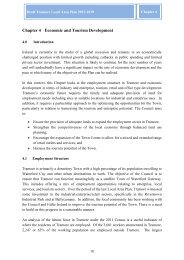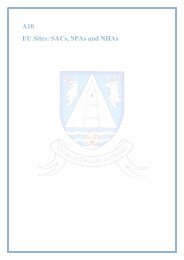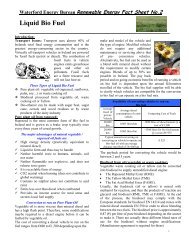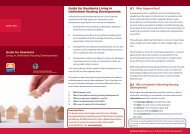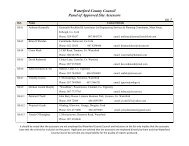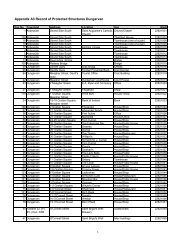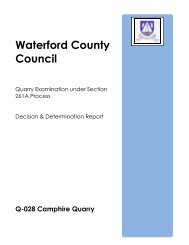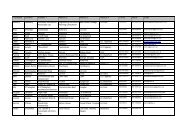South East Region Waste Management Plan - Waterford County ...
South East Region Waste Management Plan - Waterford County ...
South East Region Waste Management Plan - Waterford County ...
You also want an ePaper? Increase the reach of your titles
YUMPU automatically turns print PDFs into web optimized ePapers that Google loves.
Review of theJoint <strong>Waste</strong> <strong>Management</strong><strong>Plan</strong>for the <strong>South</strong> <strong>East</strong> <strong>Region</strong>Proposed <strong>Plan</strong> - 2005Volume 1 - Executive SummaryOctober 2005
REVIEW OF THEJOINT WASTE MANAGEMENT PLANFOR THESOUTH EAST REGIONPROPOSED PLAN - 2005VOLUME 1 - EXECUTIVE SUMMARYUser is Responsible for Checking the Revision Status of This DocumentRev. Nr. Description of Changes Prepared by: Checked Approved by: Date:by:0 Issue to Client ET BG ET 16/09/05Client:Keywords:Abstract:<strong>South</strong> Tipperary <strong>County</strong> CouncilJoint <strong>Waste</strong> <strong>Management</strong> <strong>Plan</strong>, Material Recovery Facility, Disposal,thermal treatment, recycling, recovery, awareness.The six authorities of the <strong>South</strong> <strong>East</strong> <strong>Region</strong> adopted a Joint <strong>Waste</strong><strong>Management</strong> <strong>Plan</strong> in 2002 which covered the planning period 2000 –2021. This document is the Executive Summary for the Review of this<strong>Plan</strong>. The proposed review covers the time period 2005 – 2025.
TABLE OF CONTENTSPAGE1. INTRODUCTION...................................................................................................... 11.1. AUTHORISATION .................................................................................................. 11.2. DEFINITION OF PURPOSE ..................................................................................... 11.3. OBJECTIVE.......................................................................................................... 11.4. METHODOLOGY................................................................................................... 21.5. BACKGROUND ..................................................................................................... 22. POPULATION AND DEVELOPMENT .................................................................... 42.1. NATIONAL SPATIAL STRATEGY ............................................................................. 42.2. REGIONAL PLANNING GUIDELINES........................................................................ 52.3. OTHER SPECIFIC POLICIES .................................................................................. 53. REPORTED WASTE GENERATION ...................................................................... 63.1. HOUSEHOLD WASTE............................................................................................ 63.1.1. Composition of Household <strong>Waste</strong>............................................................... 73.1.2. Household Hazardous <strong>Waste</strong> ..................................................................... 73.2. COMMERCIAL WASTE .......................................................................................... 83.3. INDUSTRIAL WASTE ............................................................................................. 93.4. PRIORITY WASTE STREAMS ............................................................................... 103.4.1. Packaging ................................................................................................. 103.4.2. Construction and Demolition <strong>Waste</strong>.......................................................... 113.4.3. <strong>Waste</strong> Electrical and Electronic Equipment (WEEE) ................................ 113.5. WASTE MOVEMENTS ......................................................................................... 113.5.1. Inter-<strong>Region</strong>al <strong>Waste</strong> Movement............................................................... 113.5.2. Exports of <strong>Waste</strong>....................................................................................... 114. EXISTING WASTE MANAGEMENT ARRANGEMENTS...................................... 124.1. COLLECTION OF HOUSEHOLD, COMMERCIAL AND INDUSTRIAL WASTE................. 124.2. WASTE MANAGEMENT INFRASTRUCTURE ........................................................... 134.3. PROPOSED WASTE MANAGEMENT FACILITIES FOR THE SOUTH EAST REGION ..... 134.3.1. Proposed Landfill Facilities ....................................................................... 134.4. WASTE ENFORCEMENT...................................................................................... 134.5. LOCAL AUTHORITY WASTE INITIATIVES IN THE SOUTH EAST REGION................... 145. WASTE GENERATION FORECASTS .................................................................. 185.1.1. Short Term Requirements......................................................................... 196. POLICY DEVELOPMENT & POLICY DECISION MAKING CRITERIA................ 206.1. ENVIRONMENTAL ASSESSMENT ......................................................................... 206.2. ABILITY TO MEET EUROPEAN AND NATIONAL WASTE MANAGEMENT TARGETS..... 206.3. FINANCIAL ASSESSMENT.................................................................................... 226.3.1. Financial evaluation of these scenarios .................................................... 226.4. SUMMARY ......................................................................................................... 22Public Consultation i/iv October 2005
TABLE OF CONTENTSPAGE7. SPECIFIC POLICY AND OBJECTIVES FOR THE REGION................................ 247.1. PUBLIC AWARENESS AND EDUCATION................................................................ 247.2. PREVENTION AND MINIMISATION ........................................................................ 247.3. WASTE COLLECTION AND CHARGING ................................................................. 257.4. WASTE RECOVERY AND RECYCLING .................................................................. 267.5. WASTE TREATMENT .......................................................................................... 277.6. NATIONAL HAZARDOUS WASTE MANAGEMENT PLAN .......................................... 297.7. PRIORITY WASTE STREAMS ............................................................................... 307.8. MARKET DEVELOPMENT .................................................................................... 317.9. POLICY ON JOINT MANAGEMENT AND PROCUREMENT......................................... 317.10. LOCATION OF WASTE MANAGEMENT FACILITIES.............................................. 317.11. COMPLAINTS MANAGEMENT ........................................................................... 328. WISER WAYS’ PUBLIC AWARENESS & INFORMATION CAMPAIGN ............. 338.1. PUBLIC AWARENESS AND INFORMATION STRATEGY............................................ 339. IMPLEMENTATION – PROGRAMME & MONITORING....................................... 349.1. INTRODUCTION.................................................................................................. 349.2. IMPLEMENTATION PROGRAMME ......................................................................... 349.3. PROCUREMENT (INFORMATION PURPOSES ONLY) ............................................... 379.3.1. Public/Private Partnership......................................................................... 37Public Consultation ii/iv October 2005
LIST OF TABLESPAGETABLE 3.1: WASTE ARISINGS IN THE SOUTH EAST REGION 2003 ..................................... 6TABLE 3.2: TOTAL HOUSEHOLD WASTE REPORTED AS COLLECTED IN THE REGION IN 2003.................................................................................................................... 7TABLE 3.3: HOUSEHOLD HAZARDOUS WASTE COLLECTION ............................................. 8TABLE 3.4: TOTAL COMMERCIAL WASTE QUANTITIES REPORTED AS COLLECTED IN 2003BY THE PRIVATE SECTOR .............................................................................. 8TABLE 3.5: TOTAL INDUSTRIAL WASTE QUANTITIES MANAGED IN THE REGION 2003 (ASREPORTED)................................................................................................... 9TABLE 3.6: MAIN SOURCE OF PACKAGING WASTE ARISINGS IN THE SOUTH EAST REGION(2003)........................................................................................................ 10TABLE 3.7: KNOWN VOLUME OF INTER REGIONAL WASTE MOVEMENT ........................... 11TABLE 4.1: PROPOSED LANDFILL FACILITIES (ANNUAL INPUT AND EXPECTED LIFESPAN) 13TABLE 4.2: SUMMARY OF THE PUBLIC AWARENESS INITIATIVES IN EACH COUNTY........... 15TABLE 5.1: WASTE ARISINGS FORECAST FOR THE SOUTH EAST REGION 2006-2026 ..... 18TABLE 5.2: WASTE TONNAGES FOR THE BASE YEAR 2006.............................................. 18TABLE 5.3: WASTE TONNAGES FOR THE DESIGN YEAR 2011 .......................................... 18TABLE 5.4: DESIGN YEAR 2011 .................................................................................... 19TABLE 6.1: RECOVERY, RECYCLING AND DISPOSAL INDICATORS FOR EACH SCENARIO... 21TABLE 6.2: BIO-DEGRADABLE WASTE ........................................................................... 21TABLE 6.3: AVERAGE WASTE MANAGEMENT COST PER TONNE – SCENARIOS 1-3.......... 22TABLE 6.4: ENVIRONMENTAL, RESOURCE AND FINANCIAL ASSESSMENT SUMMARY OFSCENARIOS 103 (2011) .............................................................................. 22TABLE 9.1: PROGRAMME OF IMPLEMENTATION OF THE JOINT WASTE MANAGEMENT PLAN.................................................................................................................... 36Public Consultation iii/iv October 2005
TABLE OF FIGURESPAGEFIGURE 1.1: WASTE MANAGEMENT HIERARCHY................................................................ 2FIGURE 2.1: POPULATION PROJECTIONS TO 2036............................................................. 4FIGURE 3.1: ESTIMATED FRACTIONS OF HOUSEHOLD WASTE COLLECTED IN THE REGION,2003 (AS REPORTED).................................................................................... 7FIGURE 3.2: ESTIMATED FRACTIONS OF COMMERCIAL WASTE REPORTED AS COLLECTED INTHE SOUTH EAST 2003................................................................................. 9FIGURE 4.1: PERCENTAGE OF HOUSEHOLDS SERVICED BY LOCAL AUTHORITY OR PRIVATECONTRACTOR COLLECTION AND PERCENTAGE OF HOUSES UNSERVICED IN 2003.................................................................................................................. 12Public Consultation iv/iv October 2005
1. INTRODUCTION1.1. Authorisation<strong>South</strong> Tipperary <strong>County</strong> Council is the Lead Authority and is acting on behalf of the sixauthorities, of the <strong>South</strong> <strong>East</strong> <strong>Region</strong>, for the preparation of the Review of the Joint <strong>Waste</strong><strong>Management</strong> <strong>Plan</strong> for the <strong>South</strong> <strong>East</strong>.The constituent local authorities participating in the plan and which form the region are:• Carlow <strong>County</strong> Council • <strong>Waterford</strong> City Council• Kilkenny <strong>County</strong> Council • <strong>Waterford</strong> <strong>County</strong> Council• <strong>South</strong> Tipperary <strong>County</strong> Council • Wexford <strong>County</strong> CouncilIn this document, the use of the term “<strong>Region</strong>” refers to the six authorities and their functionalareas (including Urban District and Town Councils).1.2. Definition of PurposeThe purpose of the <strong>Plan</strong> is:• to promote waste prevention and minimisation through source reduction, producerresponsibility and public awareness.• a management plan for the recovery/recycling/disposal of waste arisings on a regionalbasis.The period for which the <strong>Plan</strong> provides is 2005 – 2020. The <strong>Plan</strong> will be reviewed at least onceevery five years in accordance with the <strong>Waste</strong> <strong>Management</strong> Act 1996.1.3. ObjectiveThe Primary Objective of the <strong>Plan</strong> is to secure the best environmental management of all wasteincluding preventing and minimising the generation of waste wherever practicable.In order of priority, waste must be re-used, recycled, recovered and disposed of safely, havingregard to the best value solution, the utilisation of waste as a resource, public health,environmental protection and occupational hazards in waste handling.Public Consultation Page 1 of 37 October 2005
1.4. MethodologyThe basic methodology for producing the plan is outlined below:• public advertisement • recommendations & draft plan• submissions from public and private • client reviewsectors• amendments• data collection • publish draft plan• trends • submissions from public (statutory)• scenarios & preliminary assessment • finalise plan• options assessment1.5. BackgroundIn 2002, the Government issued a policy document, ‘Prevention and Recycling – DeliveringChange’. The policy statement provides for the support and development of recovery andrecycling infrastructure.In April 2004 the Government issued a further national waste management policy document –“<strong>Waste</strong> <strong>Management</strong>: Taking Stock and Moving Forward”. Taking Stock assesses progress onthe implementation of a variety of aspects of the <strong>Waste</strong> <strong>Management</strong> Act 1996 over the last fiveyears. It sets down new challenges in light of the findings of this assessment.The document highlights the following key issues in relation to <strong>Waste</strong> <strong>Management</strong> <strong>Plan</strong>s:• Revised waste plans must better address the role and needs of private sector wastemanagement service providers.• Insufficient public awareness about waste plans.• Revised waste plans must be subject to a mechanism to monitor implementation, withlocal authorities being obligated to prepare an annual report on waste plan progresswithin three months of the end of each year.• All revised waste plans are required to set out a timetable for the provision of each of theelements of the infrastructure required to make up the integrated mix of options.The policy statement also reaffirms the waste management hierarchy, which is shown in Figure1.1.Figure 1.1:<strong>Waste</strong> <strong>Management</strong> HierarchyPublic Consultation Page 2 of 37 October 2005
The <strong>Waste</strong> <strong>Management</strong> Act (1996) sets out the legislative framework to develop wastemanagement policies and Section 22 of this Act allows local authorities to act jointly to create anarea waste management plan.<strong>Waste</strong> management targets, which are set out by either policy documents or EU Directives, areas follows:Packaging Directive (94/62/EC) by:• 2001 25% recycling rate for packaging waste• 2005 50-65% recovery rate• 2005 25-45% recycling rate• 2005 15% minimum recycling rate for each materialLandfill Directive (99/31/EC)Reduce amount of biodegradable material going to landfill to the percentages below of the totalamount of this material produced in 1995 by:• 2006 75%• 2009 50%• 2016 35%Public Consultation Page 3 of 37 October 2005
2. POPULATION AND DEVELOPMENTA Population Census was carried out in Ireland in 2002. The population of the <strong>South</strong> <strong>East</strong>region was given as 423,256 persons. This is an increase of 31,739 persons or 7.5% from 1996.The <strong>South</strong> <strong>East</strong> <strong>Region</strong> accounts for 10.8% of the State’s population.57 % of the population of the <strong>South</strong> <strong>East</strong> <strong>Region</strong> (2002) lives in rural areas, where rural isdefined as the countryside or villages with a population of less than 1,500.A recent publication by the CSO (Fig 2.1 –CSO (2)), on population and labour force projections,predicts national populations for the period 2006-2036. These predictions have been used toestimate the predicted future population of the <strong>South</strong> <strong>East</strong> <strong>Region</strong>.Figure 2.1: Population Projections to 2036Population Projections, CSO 2001Census dataPopulation Estimate, CSO (1) 2004 Population Projections CSO (2) 2004population of the <strong>South</strong> <strong>East</strong> <strong>Region</strong>600,000500,000400,000300,0001996 2001 2002 2004 2006 2011 2016 2021 2026 2031 20362.1. National Spatial StrategyThe National Spatial Strategy (NSS) sets out a framework for future development and growth inIreland over the next twenty years.The NSS identifies <strong>Waterford</strong> as one of the five nationally significant gateways supported byKilkenny and Wexford as hubs. The NSS identifies these towns as a nationally strategic ‘growthtriangle’ in the <strong>South</strong> <strong>East</strong> and regional growth will be driven through these towns. Populationgrowth requires increased services and facilities and this encourages greater economic activityand an improved quality of life. However, it also leads to increased waste generation.Public Consultation Page 4 of 37 October 2005
2.2. <strong>Region</strong>al <strong>Plan</strong>ning GuidelinesThe <strong>Plan</strong>ning and Development Act (2000) gave <strong>Region</strong>al Authorities the power to generate<strong>Region</strong>al <strong>Plan</strong>ning Guidelines (RPG). The RPG for the <strong>South</strong> <strong>East</strong> reiterate the policy of theNational Spatial Strategy (NSS) and identifies <strong>Waterford</strong>, Kilkenny and Wexford as a strategic“growth triangle”. The guidelines identify nine key areas for investment and development withinthe region. One of these is the full implementation of the Joint <strong>Waste</strong> <strong>Management</strong> <strong>Plan</strong> for the<strong>South</strong> <strong>East</strong> <strong>Region</strong>2.3. Other Specific Policies<strong>Region</strong>al and national policies have been reviewed to assess their impact or requirements fromthe perspective of waste management. Both the National Spatial Strategy (NSS) and theRevitalising Areas by <strong>Plan</strong>ning, Investment and Development (RAPID) programme have beenput in place to encourage the socio-economic growth of the region and in the case of RAPID thepreferential development of disadvantaged areas within the region. Both policy documentsenvisage increased population and economic growth within the region, the impact of thesuccessful implementation of these policies is the potential for increased waste production in allwaste streams.Public Consultation Page 5 of 37 October 2005
3. REPORTED WASTE GENERATIONReported municipal solid waste (MSW) generation in the <strong>South</strong> <strong>East</strong> <strong>Region</strong> is outlined in Table3.1.Table 3.1: <strong>Waste</strong> Arisings in the <strong>South</strong> <strong>East</strong> <strong>Region</strong> 2003Total (t)Hazardous<strong>Waste</strong> TypeFraction (t)Household 136,326 430Commercial 86,262 Note 1Industrial 45,735 Note 1Industrial Sludges (non-hazardous) (tDS) 91,543 0Litter and Street Cleansing 8,490 0Agricultural 435,180 no dataC&D 430,000 0Contaminated soils 2,834 2,834Municipal sludges (tDS) (water treatment) 1,277 no dataSewage sludge (tDS) 5,603 no dataHealthcare waste 955 955Mining and quarrying waste 700,000 no dataAsh and other incineration residues 55 55Priority <strong>Waste</strong>s 6,534 747Port <strong>Waste</strong> 0Hazardous <strong>Waste</strong> (not reported as other fractions ) 17,000 17,000Note 1: The quantities of waste above are tonnes of waste as reported. Where no returns were reported an estimatehas been made. Details of reported and or estimated waste fractions are discussed in further detail in the followingsections.Note 2: Priority hazardous wastes and healthcare waste are included separately in the table. There was nodifferentiation between commercial and industrial hazardous waste in the returns. They are included as the fraction‘hazardous waste’.3.1. Household <strong>Waste</strong>A total of 136,326 t of household waste was reported to be collected in the <strong>South</strong> <strong>East</strong> <strong>Region</strong> in2003.The total quantities collected are outlined in Table 3.2 overleaf.Public Consultation Page 6 of 37 October 2005
Table 3.2: Total Household <strong>Waste</strong> Reported as Collected in the <strong>Region</strong> in 2003Local AuthorityAreaTotalHousehold <strong>Waste</strong>(t)household wastecollected by area(%)Carlow 18,169 13.5Kilkenny 14,936 11<strong>South</strong> Tipperary 26,988 20<strong>Waterford</strong> <strong>County</strong> 15,356 11<strong>Waterford</strong> City 22,299 16.5Wexford 38,578 28Total 136,326 1003.1.1. Composition of Household <strong>Waste</strong>Each local authority carried out household waste composition surveys for the 2001 National<strong>Waste</strong> Database. After review of a number of other household waste characteristics, the NWD,the 2001 data was used to produce an estimate of household waste composition analysis forthe <strong>South</strong> <strong>East</strong> <strong>Region</strong>. <strong>Waste</strong> composition is shown in Figure 3.1. The composition is basedon the total tonnage reported as collected in the region in 2003.Figure 3.1:Estimated Fractions of Household <strong>Waste</strong> Collected in the <strong>Region</strong>,2003 (as reported)19422glasspaper/cardboardmetalplastic4textile3512organic4other3.1.2. Household Hazardous <strong>Waste</strong>It is estimated that 21,600 t of hazardous waste was generated in 2003.The local authorities within the region have implemented measures to divert this waste streamfrom landfill. These are outlined in Table 3.3.Public Consultation Page 7 of 37 October 2005
Table 3.3:Household Hazardous <strong>Waste</strong> Collection<strong>County</strong>CarlowKilkenny<strong>South</strong> Tipperary<strong>Waterford</strong> <strong>County</strong>WexfordCollection MeasuresChemcar© CollectionChemcar© CollectionDedicated collection receptacles placed at DunmoreRecycling CentreChemcar© CollectionDedicated collection receptacles placed at Lismore,Dungarvan and Tramore recycling centres.Returnbatt receptacles, M. Barter Recycling, AtlasEnvironmental, receptacles at recycling centres forhousehold hazardous waste, Chemcar© collection,annual waste action days – collection of householdhazardous waste.The Chemcar © is operated by Cara <strong>Waste</strong> <strong>Management</strong>3.2. Commercial <strong>Waste</strong>In 2003, 86,000t of commercial waste was reported as collected in the region. All commercialwaste is collected by private contractors. The majority of commercial waste is collected fromcommercial premises. A breakdown of the commercial waste collected in the region by privatecontractors is shown in Table 3.4.Table 3.4: Total Commercial <strong>Waste</strong> Quantities Reported as Collected in 2003by the Private SectorAreaMixed <strong>Waste</strong>(t)SeparateCollection (t)Total(t)Carlow 5,941 0 5,941Kilkenny 3,261 4,242 7,609Tipperary <strong>South</strong> 9,636 6,474 16,110<strong>Waterford</strong> City 11,758 4,871 16,629<strong>Waterford</strong> <strong>County</strong> 11,432 0 11,432Wexford 10,970 17,571 28,541Total 54,526 33,158 86,262Public Consultation Page 8 of 37 October 2005
Figure 3.2:Estimated Fractions of Commercial <strong>Waste</strong> Reported as Collected inthe <strong>South</strong> <strong>East</strong> 20039GlassTextile7 14921Paper/CardboardMetal103PlasticOrganicOther3.3. Industrial <strong>Waste</strong>A <strong>Region</strong>al <strong>Waste</strong> Audit was carried out in November 2004. Private waste contractors collectindustrial waste that is not managed at the point of origin.Table 3.5:Total industrial waste quantities managed in the region 2003 (asreported)<strong>County</strong><strong>Waste</strong> ArisingsCarlowNot availableKilkenny 14,050<strong>South</strong> Tipperary 4,828<strong>Waterford</strong> City 13,806<strong>Waterford</strong> <strong>County</strong> 926Wexford 12,125TOTAL 45,735Note 1 – included in commercial collectionPublic Consultation Page 9 of 37 October 2005
3.4. Priority <strong>Waste</strong> StreamsThe European Commission has established specific measures, which aim to manage/preventspecific waste streams. The following waste streams were given priority by the EU:• packaging waste • Construction and Demolition <strong>Waste</strong>• healthcare waste• <strong>Waste</strong> Electrical and Electronic Equipment• batteries(WEEE)• Polychlorinated Biphenyls (PCB’s) • waste oils• End of Life Vehicles (ELV’s) • waste tyres<strong>Waste</strong> arisings of a number of priority waste streams are discussed below, please refer to the<strong>Plan</strong> for other priority wastes.3.4.1. PackagingItems such as glass bottles, plastic containers, food wrappers, aluminium cans and timberpallets are all classified as packaging (EPA 2001). The main source of packaging waste ishighlighted in bold in Table 3.6. Smaller amounts of packaging waste are also found in metalsi.e. aluminium cans.Table 3.6:Main Source of Packaging <strong>Waste</strong> Arisings in the <strong>South</strong> <strong>East</strong> <strong>Region</strong>(2003)Household<strong>Waste</strong> Type % of Total Householdfractions(t)%PackagingCommercial/Industrial% of Total Commercialfractions (t)% PackagingGlass 4 5,453 4 7 6,038 1.0Paper/Cardboard 22 29,992 6 49 42,268 30Metal 4 5,453 3 10 8,626 2Plastic 12 16,359 10 3 2,588 8Textile 4 5,453 1 863Organic 35 47,714 21 18,115Other 19 25,902 9 7,764Total waste 100 136,326 100 86,262Main Source Packaging 31,355 23% 35,367 41%The NWD Interim Report 2002, estimates that 0.229 tonnes of municipal packaging waste isproduced per capita. At this rate of generation 97,000 t of packaging waste is estimated. Basedon Table 3.6 a generation note of 202 kgs/capita can be calculated giving a total packagingwaste arising of 85,481 t. An estimate of 100,000 t will be assumed for the purposes of the planin the absence of reported data.Public Consultation Page 10 of 37 October 2005
3.4.2. Construction and Demolition <strong>Waste</strong>Employment in the building and construction sector in the <strong>South</strong> <strong>East</strong> at 10.1%, using this figureas an indicator of construction activity and construction waste generation gives 369,000 t/a ofC&D in the region in 2001. The period 2002 and 2003 showed a significant increase in houseconstruction of the plan and it is anticipated that this gave rise to a higher than average increasein C&D generation. A figure of 500,000 t/a is assumed.3.4.3. <strong>Waste</strong> Electrical and Electronic Equipment (WEEE)In 2003, reported WEEE generation was 673 tonnes. This generation volume is low whencompared with estimated generation rates outlined in the EPA Report 47 . The volume of WEEEpredicted to be produced per capita is estimated at between 9 kgs and 18 kgs for the period2001-2005. Assuming an average generation rate of 13.5 kgs per capita predicted WEEEgeneration for the region should be in the range of 5,700 tonnes per annum. An indicativeEuropean value for WEEE arisings throughout the member stated is 20kg per inhabitant/year.A lower value was calculated by the EPA for Ireland based on a material flows approach, i.e.sales of items of electrical and electronic equipment.3.5. <strong>Waste</strong> Movements3.5.1. Inter-<strong>Region</strong>al <strong>Waste</strong> MovementReduced landfill capacities, introduction of landfill quotas, non-acceptance of commercial wasteat some local authority operated landfills, increased gate-fees and the introduction of sourceseparation of dry recyclables have influenced inter-regional movement of commercial and dryrecyclable waste in particular and some household waste.Estimated volume of inter-regional waste movement is shown in Table 3.7.Table 3.7:Known Volume of Inter <strong>Region</strong>al <strong>Waste</strong> Movement<strong>Waste</strong> Type Quantity (Tonnes) % of <strong>Waste</strong> StreamCommercial 16,629 19.2Household 3,140 2.3Dry Recyclables Note 1 13,928 34.5Total 33,697Note 1 – Volume of dry recyclables shipped directly from the region prior to sorting.3.5.2. Exports of <strong>Waste</strong>6,130 t of waste was exported from the region in 2003. This does not include certain types ofwaste that do not require notifications, such as green list waste being exported for recovery.There is no overall figure for waste exports. No waste was imported into the region from abroadin 2003.Public Consultation Page 11 of 37 October 2005
4. EXISTING WASTE MANAGEMENT ARRANGEMENTS4.1. Collection of Household, Commercial and Industrial <strong>Waste</strong>The local authorities are only involved in household waste collection, all other waste types arecollected by private contractors.The share of the household collection market is shown in Figure 4.1. In general very poor datawas supplied for the commercial and industrial sector in terms of segregated collection. Data isincluded where available.Figure 4.1:Percentage of households serviced by local authority or privatecontractor collection and percentage of houses unserviced in 2003households serviced by the local authority households serviced by private contractors unserviced households1009018 20148010% of total households7060504010017251007036304357502010070Co. Carlow Co. Kilkenny <strong>South</strong> Tipperary <strong>Waterford</strong> City Co. <strong>Waterford</strong> Co. WexfordOn average, 14% of all households in the region are unserviced, either due to remoteness fromthe services or non-participation.Public Consultation Page 12 of 37 October 2005
An Environmental Network has been established by the OEE in conjunction with all localauthorities. The network’s objective is to foster cooperation in waste enforcement so that amore consistent standard is achieved throughout the country.Up to 2003, the majority of local authority staff with waste management functions were involvedin the issuing of permits with fewer staff involved in enforcement activities. To address staffingdeficiencies in waste enforcement, local authorities were permitted to recruit staff to establishwaste enforcement teams,The main functions of waste enforcement staff are to:• respond to and investigate third party complaints in relation to waste activities• respond to unauthorised waste activities identified through effective enforcement• undertake audits/inspections of permitted facilities and collectors4.5. Local Authority <strong>Waste</strong> Initiatives in the <strong>South</strong> <strong>East</strong> <strong>Region</strong>Since the publication of the JWMPSE there has been a significant increase in public awarenessinitiatives in the region. This can be attributed to the work of the Public Awareness Officers ineach of the local authorities. These Officers are responsible for liaising with all sectors of thecommunity including schools, businesses and the waste industry. The theme of theirawareness/education campaigns compliment the elements of the National Race Against <strong>Waste</strong>(RAW) campaign as well as the <strong>Waste</strong> Initiatives for the <strong>South</strong> <strong>East</strong> <strong>Region</strong> (W.I.S.E.R. Ways).All elements of the environmental education and awareness programme in the <strong>South</strong> <strong>East</strong><strong>Region</strong> complement the elements of the National Race Against <strong>Waste</strong> campaign by thepromotion of preventing, reducing, reusing and recycling initiatives across the region. Educationand awareness programmes are aimed at various audiences, as previously identified in theJWMPSE (2002) including (but not limited to):• domestic households• youth groups (including schools and youth reach groups)• commerce & industry (promotion of the RAW Small Change Campaign)• agricultural sector (delivering REPS waste management training courses)• community leaders & representativesPublic awareness initiatives in each of the regions local authorities are summarised in Table 4.2.Public Consultation Page 14 of 37 October 2005
Table 4.2: Summary of the Public Awareness Initiatives in each <strong>County</strong>Schools Households Commerce & Industry Community InitiativesCarlow • battery recycling scheme• schools education programme• green schools workshops• providing advice on compostingand other recycling equipmentfor schoolsKilkenny • battery recycling scheme• schools education programme• free compost bins• green schools workshops• developing anti-litter andenvironmental projects• fieldtrips to local wasteinfrastructure• litter campaign• operation of 44 bring banks & 3civic amenities• pilot kerbside scheme• six recycling banks for newspaperand magazines• a regular household hazardouswaste collection service isprovided through a mobilecollection service• subsidised compost bins• composting workshops• operation of 44 bring banks & 1recycling centre• subsidised compost bins• composting workshops• kerbside collection scheme• free collection of fridges andfreezers at Dunmore CA until12th August 2005• A regular household hazardouswaste collection service isprovided through a mobilecollection service• workshops for businesses in the<strong>County</strong>• provide Guides for Managing<strong>Waste</strong>• enforcement of the PackagingRegulations• regular meetings with theChamber of Commerce &commercial waste clubs• production of a Guide topackaging regulations and wastemanagement• enforcement of the PackagingRegulations• restrictions on recyclable materialgoing to landfill (cardboard, glass,aluminium, steel, timber,newsprint and magazines)• provision of an advisory service tobusinesses on recycling services• waste audits to demonstrate howwaste management bills can bereduced and recycling ratesincreased• visiting youth groups outsidethe school environment• presentations to residentscommittees and communitygroups• distribution of composters tolocal communities throughschools• community compostingprojects in Freshford andPiltown• estate management projectsfor <strong>County</strong> Council EstatesPublic Consultation Page 15 of 37 October 2005
Table 4.2: Summary of the Public Awareness Initiatives in each <strong>County</strong> Cont’d………..Schools Households Commerce & Industry Community Initiatives<strong>South</strong>Tipperary• battery recycling scheme• schools education programme• provision of Compost Bins• Green Schools workshops• developing anti-litter andenvironmental projects• fieldtrips to local wasteinfrastructure• litter campaign• tidy schools competition<strong>Waterford</strong> City • schools education programme• Green Schools workshops<strong>Waterford</strong><strong>County</strong>• schools education programme• free compost bins andworkshops on composting andvermicomposting.• Green Schools workshops• anti-litter and environmentalprojects• litter campaign• annual environmental awardscampaign• annual primary schools award• battery recycling programmesfor schools• Kids zone web-pages on theCouncil website.• operation of 73 bring banks & 1recycling centre• compost bins• composting workshops• kerbside collection scheme• collection of fridges and freezers• A regular household hazardouswaste collection service isprovided through a mobilecollection service.• operation of 23 bring banks & 1recycling centre• 3-bin kerbside collection scheme• operation of 43 bring banks & 3civic amenities• 3-bin kerbside collection scheme• compost bins• annual environmental awardscampaign• in-house recycling scheme atlocal authority office offices• enforcement of the PackagingRegulations• organic waste collection• promotion of the Small ChangeCampaign• promotion of the Take Action atwork campaign• Enforce <strong>Waste</strong> Packaging Regs• promotion of the NationalSpring Clean Programme• anti-litter grants target differentsectors of the community• comprehensive scheme ofawards including tidy burialgrounds, tidy towns andvillages etc.• assistance in terms of litterpickers/ bags/skips etc to TidyTowns Committees• Hasbro Litter Rangers teacheschildren to care for their ownarea in <strong>Waterford</strong> City.• organisation of clean ups in<strong>Waterford</strong> City.• annual competition - make<strong>Waterford</strong> beautiful• annual communityenvironment awards campaign• promotion of National SpringClean• visits to community groups e.g.resident associations, ICAgroups, gardening clubs topromote waste reduction,reuse and recycling.• Provide funding for anti litterand local agenda 21sustainable projects.Public Consultation Page 16 of 37 October 2005
Table 4.2: Summary of the Public Awareness Initiatives in each <strong>County</strong> Cont’d………..Schools Households Commerce & Industry Community InitiativesWexford • battery recycling scheme in102 schools• battery recycling scheme at 12centres• schools education programme• Green Schools workshops• Anti-litter & environmentalprojects• fieldtrips to local wasteinfrastructure• operation of 123 bring banks & 2recycling centres• operate 28 recycling sites fornewspaper• operate 12 recycling sites forplastics• Workshop for Business in the<strong>County</strong> in association withChamber of Commerce• Enforcement of the PackagingRegulations• Restrictions on recyclablematerial going to landfill.• Promote Construction andDemolition waste recovery andrecycling• Promote Site <strong>Waste</strong> <strong>Plan</strong>s• Promote the use of appropriatecollection permit holders andwaste licensed/waste permitsites.• promote litter managementplan• community waste action daysfor collection of items includingscrap metal, TVs/VDUs,batteries, fridges, textiles• visits to community groups toencourage reusing, reducingand recycling waste• Annual Keep WexfordBeautiful Competitions• Annual Environmental Awards• Subsidised CompostBins/Promotional Campaign• Regular Dry RecyclableNewsletter updates• Telephone Help-line forRecycling at 1800 SORT IT(1800 767848)• Kerbside Collection Scheme• <strong>Waste</strong> Watch days at localhotels• Strategic <strong>Waste</strong> <strong>Management</strong>ProgrammePublic Consultation Page 17 of 37 October 2005
5. WASTE GENERATION FORECASTSFuture waste arisings were predicted using growth rates from the <strong>Region</strong>al <strong>Plan</strong>ning Guidelines,National Overview of <strong>Waste</strong> <strong>Management</strong> <strong>Plan</strong>s (NOWMP) and the JWMPSE 2002. Thegrowth factors used in the NOWMP are outlined in Table 5.1. It should be noted that the growthfactor percentage increases are not compounded. The NOWMP considers the following factorsto determine growth rates:• population statistics• economic factors• deduction in household size• level of success of the National <strong>Waste</strong> Prevention ProgrammeIt was considered that these projections are the most comprehensive waste predictions to dateand accordingly are used for projections in this proposed review.Table 5.1: <strong>Waste</strong> Arisings Forecast for the <strong>South</strong> <strong>East</strong> <strong>Region</strong> 2006-2026<strong>Waste</strong> Stream 2006* 2007* 2008* 2009* 2010 2011- -2026TotalIncreaseHousehold 5.0% 2.5% 2.4% 1.7% 1.3% 2% 44.9%Commercial/Industrial 3.3% 1.1% 1.2% 0.6% 0.3% 2% 38.5%Based on these growth rates, waste tonnages were calculated for the period 2006 – 2026. Thewaste arising estimates for 2006 and 2011 have been compared with the predictions made inthe JWMPSE in 2002 for waste arisings 2006 and 2011 in Tables 5.1 and 5.2. The estimates inTables 5.3 and 5.4 were used in the financial and scenario modelling* in both this (2005)Review and in the JWMPSE (2002). 2011 is the design year for the plan.*Household <strong>Waste</strong> estimates (2005) are based on generation of waste at 1.28 t/household anda coverage of 80% of households and include the household fraction of waste that is assumedto be home composted (4% of household fraction). Commercial waste arisings are estimatedas a 1:1 ratio with household for the baseline year.Table 5.2: <strong>Waste</strong> tonnages for the base year 2006Data Source Review (2005) JWMPSE (2002)<strong>Waste</strong> Stream 2006 (t) 2006 (t)Household 171,000 147,000Commercial/Industrial 151,000 130,000Table 5.3: <strong>Waste</strong> tonnages for the design year 2011Data Source Review (2005) JWMPSE (2002)<strong>Waste</strong> Stream 2011 (t) 2011 (t)Household 186,000 192,740Commercial/Industrial 159,000 144,780Public Consultation Page 18 of 37 October 2005
Although different growth rates were used in the original plan and in this review there are nosignificant changes.The plan has chosen 2011 as the design year. This means, waste arisings in 2011 will be usedfor waste planning purposes, such as sizing facilities. In this way planned facilities will be of areasonable size with little redundancy. Facility size requirements can be reviewed either at theplan review intervals or as part of the facility procurement process. Facilities should be sized foreconomies of scale and on a value for money basis. This may require inter-regional wastemovements to achieve these objectives.Table 5.4: Design Year 2011Fraction Range B (t) C (t) Range A (t) D (t)No. of mainfacilitiesrealisticrangeDry Recyclables (1) 130,770 181,107 172,601 177,836 5Organics (2) 51,753 69,625 65,101 67,885 2Thermal (3) minmax13,508 17,493 15,935 16,897 1121,570 157,476 143,415 152,068 1realisticLandfillResidual (Total) 135,078 174,974 159,350 168,965 1Note 1 dry recyclables, 172,000 tpa to 177,000 tpa or typically 5-6 facilities in the range of capacities of 25,000 tpa to30,000 tpaNote 2 organics, 65,000 tpa to 68,000 tpa or typically 2-3 facilities in the range of capacities of 25,000 tpa to 30,000 tpaNote 3 residual landfill/thermal, 143,000 tpa to 170,000 tpa or one facility of each type in the capacity range of 150,000tpa.5.1.1. Short Term RequirementsThe table above gives an insight into the capacity required in the short term to cover the period2005 - 2011 while recycling increases from a low level at present to required levels by 2011.Within the “realistic” range (A and D), there is an immediate requirement for disposal of between338,377 tpa to 352,822 tpa. This will reduce to between 159,350 tpa to 168,965 tpa by 2011with the provision of an integrated waste facility, (comprising thermal treatment, associatedtransfer systems, biological and dry material recovery facilities) and less than half of this rangeagain thereafter.To cater for this short term deficiency within the region, landfill capacity should be maintainedand/or developed either by extension and/or development of landfill capacity of minimum150,000 tpa. It may also be prudent to progress a second new facility to preconstruction stage(in the event of delays in the procurement process of the regional integrated facility) and toensure the region is self sufficient in this transition period.This phasing of facilities requires co-ordination between the authorities to avoid excess capacityand hence excessive cost/expenditure. Required capacity should be jointly developed as thisprovides the best opportunity to develop value for money short term solutions.Public Consultation Page 19 of 37 October 2005
6. POLICY DEVELOPMENT & POLICY DECISION MAKING CRITERIAThe formulation of the waste management policy for the <strong>Region</strong> is based on the followingcriteria:1. Environmental assessment of recommended waste management scenarios2. Ability to meet European and National waste management targets3. Financial Cost6.1. Environmental AssessmentAn environmental assessment of four waste management scenarios/strategies was carried out.In each scenario the collection, treatment and recovery of dry recyclables and bio waste is thesame. The collection, treatment and recovery/disposal of the residual bins are what differentiatethe scenarios. The scenarios for the residual bins are:• Landfill only• Mechanical & Biological Treatment (MBT)and Landfill• MBT and Thermal Treatment• Thermal TreatmentWhen the environmental burdens associated with the different waste management scenariosare examined for local impacts, options containing thermal treatment are preferred. In allenvironmental impact categories examined, the thermal treatment options resulted in avoidedenvironmental burdens. Refer to Table 6.4.6.2. Ability to Meet European and National <strong>Waste</strong> <strong>Management</strong> TargetsRecycling is defined as recycling of materials obtained through the dry recyclable collection, theorganic collection and the recyclable fraction obtained through mechanical and thermaltreatment processes.Materials recovery is defined as materials recovery which includes waste to energy andstabilised material going to co-combustion or waste to energy facilities after pre-treatment in amechanical biological facility. Recovery also includes composting.The residual that can not be recycled, recovered or thermally treated is landfilled.The following table outlines the percentage of recycling, recovery and landfill for each of thescenarios.For any scenario involving thermal treatment the recovery percentage is higher than therecycling percentage. This is because energy (heat) that is produced during the thermalprocess can be recovered. <strong>Waste</strong> that cannot be recycled or recovered can be thermallytreated and therefore the percentage of residual waste (11 and 7% respectively for thermal orthermal and MBT) going to landfill is much lower than the landfill only and MBT and landfillscenarios (48 % and 32 % respectively).Public Consultation Page 20 of 37 October 2005
Table 6.1:Recovery, Recycling and Disposal Indicators for each ScenarioLandfillThermalMBT &landfillMBT &ThermalRecovery 49% 85% 65% 89%Recycling 49% 49% 54% 54%Landfill 48% 11% 32% 7%Disposal outside of county (hazardous flyash) 0% 1.3% 0% 1.0%Disposal outside of county (dross fromrecycling) 2% 2% 2% 2%NotesThe values shown above are based on the assumption that there is a 3-bin collection system and a biologicaltreatment plant to treat separately collected biowaste.Some waste will be disposed of outside the <strong>Region</strong>, hazardous fly ash generated from thermal treatment hasto be disposed of to a hazardous waste landfill and if any recycling takes place outside the region or country,the dross arising from that fraction will be managed there.Materials for disposal are those residues, which are not recycled or recovered throughmechanical biological treatment facilities and/or thermal facilities. These would include lowquality stabilised compost from mechanical biological treatment systems.The following table sets out the primary targets for the diversion of biodegradable waste fromlandfill in the Landfill Directive and other national targets and degree of achievement. Thesediversion targets are based on waste arisings for the baseline year of 1995.Table 6.2:Bio-Degradable <strong>Waste</strong>Bio-degradable <strong>Waste</strong> Landfill MBT &ThermalTarget to divert 25% ofbiodegradable waste from landfill(2006)Target to divert 50% ofbiodegradable waste from landfill(2009)Target to divert 65% ofbiodegradable waste from landfill(2016)A diversion of 50% of overallhousehold waste away fromlandfill (2013)35% recycling of municipal waste(2013)MBT &LandfillThermal Fails to meet targetsMeets targetsExceeds TargetsIt is clear from the tables that the landfill only option for residual wastes will not achievecompliance with the landfill directive and accordingly further treatment of the materials collectedin the residual bin is required.Public Consultation Page 21 of 37 October 2005
Solutions involving thermal treatment achieve (in relative terms) higher diversion from landfilland higher recovery target rates.6.3. Financial AssessmentA financial assessment has been carried out on four (1, 2A, 2B, 3) waste managementscenarios for the region. They have been carried out over a twenty-year period and include theoperating and capital costs for the primary components of each scenario. They do not includefor operator’s profits, risk or procurement and design costs. The capital and operating costs foreach scenario are presented for the target years of 2009 and 2016 for comparative purposes.6.3.1. Financial evaluation of these scenariosThe financial model calculates the operational and investment costs for each year of the twentyyear period and also gives an average waste management cost per tonne for comparativepurposes. These costs are set out for the two target years of 2009 and 2016. These targetyears have been chosen as they correspond to two of the three target years for the diversion ofbiodegradable waste to landfill. It has also been assumed that by the year 2009 all of thecomponents of the waste management scenarios would be in place. The costing from thefinancial model for the residual waste stream is set out in Table 6.3 below and is expressed inmillions of Euro per scenario.Table 6.3: Average <strong>Waste</strong> <strong>Management</strong> Cost per Tonne – Scenarios 1-3Scenario 1 Scenario 2A Scenario 2B Scenario 3Facility Landfill MRF & Thermal MBT & Landfill Thermal€ million 2011 13 15 17 9.5€ million 2016 14 15 18 96.4. SummaryThe outcome of the environmental, resource and financial assessments are set out in Table 6.4.Table 6.4:Environmental, Resource and Financial Assessment Summary ofScenarios 103 (2011)Environmental Comparator ResourceComparatorFinancialComparatorLocal Global € million/annumScenario 1 landfill 4 4 Non Compliant 14Scenario 2(a)MBT & Thermal2 2 / 15Scenario 2(b)MBT & Landfill3 3 18Scenario 3Thermal1 1 9Public Consultation Page 22 of 37 October 2005
In summary, both thermal options show improved performance over the two landfill options.Residual waste to landfill without pre-treatment will be non-compliant will EU targets after 2009.Accordingly Scenario 3 with thermal treatment of the residual waste stream is the preferredoption to form part of an integrated waste management approach in the <strong>South</strong> <strong>East</strong> <strong>Region</strong>.Public Consultation Page 23 of 37 October 2005
7. SPECIFIC POLICY AND OBJECTIVES FOR THE REGIONThe specific policy and objectives of the <strong>South</strong> <strong>East</strong> <strong>Waste</strong> <strong>Management</strong> <strong>Region</strong> (<strong>Region</strong>) areset out hereunder and grouped into the following sections:• Public Awareness and Education • Litter Prevention• Prevention and Minimisation • Sludge <strong>Management</strong>• <strong>Waste</strong> Collection and Charging • National Hazardous <strong>Waste</strong> <strong>Management</strong>• <strong>Waste</strong> Recovery and Recycling<strong>Plan</strong>• <strong>Waste</strong> Treatment/Final Disposal • Priority <strong>Waste</strong> Streams• Unauthorised Landfilling • Market Development• Location of <strong>Waste</strong> <strong>Management</strong> • Policy on Joint <strong>Management</strong> andFacilitiesProcurement7.1. Public Awareness and EducationThe aims of the waste management plan are to:• Minimise waste production• Recover waste• Promote waste prevention• Recycle waste• Manage waste in the most appropriateenvironmental mannerThe regions awareness programme will be based on the national campaign and tailored todevelop local and regional campaigns.Public awareness initiatives will lay the communications foundation for important events aroundwhich the plan will be delivered. These include:• Roll-out of new collection schemes and methods• Increasing and maintaining public participation in recycling initiatives etc.• Establishment of the necessary waste management infrastructureIn the procurement of waste services for the implementation of this plan, all or a portion of thepublic awareness and education initiatives may be transferred to the contracting entity/privatesector.7.2. Prevention and MinimisationThe 1989 community strategy for waste prevention set outs 3 fundamental concepts behind EUwaste strategy:• waste prevention• waste recovery• waste disposalPublic Consultation Page 24 of 37 October 2005
The most recent Sixth Environmental Action Programme outlines four main waste related aimsand these are to:• develop a thematic strategy on sustainable use and management of resources• develop and implement measures on waste management and prevention• develop a thematic strategy on waste recycling• revise the legislation on wasteTo implement the Sixth Environmental Action Programme at local level the <strong>Region</strong> will target thefollowing key areas for specific action:• Drawing up estimates of materials and waste stream flows within, into or out of the<strong>Region</strong>• Raising awareness of the public’s potential contribution to waste reduction• Developing further indicators in the field of waste management• Develop and implementing measures aimed at ensuring source separation and thecollection and recycling of priority waste streamsMeeting these requirements will be achieved partly by a comprehensive and pro-active wasteeducation and awareness campaign focusing on the public and commercial sectors. The themeof these local (and regional) initiatives will complement the initiatives under the “Race Against<strong>Waste</strong>” campaign and other National initiatives such as the National <strong>Waste</strong> PreventionProgramme.National <strong>Waste</strong> Prevention ProgrammeIt will be the policy of the <strong>Region</strong> to promote the objectives of the National <strong>Waste</strong> PreventionProgramme. These objectives will be achieved through education and awareness with theultimate aim of decoupling waste generation and economic growth. The <strong>Waste</strong> PreventionProgramme will target six key waste streams:• Agriculture – waste packaging, oily sludges, sheep dip, farm plastics• Industry – small to medium size enterprises• Construction and demolition waste• Mining and quarrying waste – stone and quarrying activities• Municipal waste• Hazardous waste<strong>Waste</strong> streams subject to producer responsibility initiatives will be included.7.3. <strong>Waste</strong> Collection and ChargingIt is the policy of the <strong>Region</strong> to promote and apply a “pay-by-use “charging system for allmunicipal solid waste (MSW) collections.The <strong>Region</strong> may produce common guidelines and/or Bye-Laws to implement pay-by-use policy.It is the policy of the <strong>Region</strong> that 80-85% on average (unless it is deemed unreasonable to doso by the local authorities) of all households in the <strong>Region</strong> will have a waste collection serviceprovided either by the Local Authorities and/or private sector by 2008.Public Consultation Page 25 of 37 October 2005
For the 15-20% of households that may not have access to a collection service the regionproposes to adopt and implement the following waste management strategy:• Promotion and support for home composting• Identification, development and servicing of strategically located collection points for dryrecyclables and residual waste• Apply the polluter pays principal to the collection of waste streams subject to resources• Implementation of an information and awareness campaign aimed at reducing the extentof backyard burning and fly tipping in the regionFor the commercial/industrial sector all waste arisings shall either be:• managed on site by segregation of waste under the Packaging Regulations, or• source segregated by the implementation of a 2-bin system (pre 2006) (dry recyclablesand residual waste) and collected by a permitted collector.Not later than 2006, all waste collection services for household, commercial and industrial in theregion shall comprise of a 2-bin system for dry recyclables and residual waste.It is the objective of this plan that residual waste collected in the region will be directed underthe <strong>Waste</strong> <strong>Management</strong> (Collection) Permit Regulations to an appropriate disposal facility.Accordingly the council may direct waste to specific waste facilities within the region.7.4. <strong>Waste</strong> Recovery and RecyclingCollection and recycling efficiencies for the component waste streams in household andcommercial/industrial waste are set out in Section 9. <strong>Waste</strong> collectors and operators of wasteinfrastructure facilities either proposed or subject to review shall demonstrate their degree ofcompliance with these collection and recycling efficiencies. The region will have regard to thedegree of compliance demonstrated when evaluating waste collection and/or infrastructurepermit applications or reviews.The specific policy of the <strong>Region</strong> in relation to recovery/recycling efficiencies is to enable theachievement of the targets set out hereunder:• Home composting shall be available to not less than 7% of all households in the <strong>Region</strong>.• The <strong>Region</strong> shall provide or arrange for the provision of bring centres with the emphasison quality of location, presentation and range of receptacles. The <strong>Region</strong> shall keepunder review the density of sites per thousand of population and the collection frequencynecessary to enhance the management of bring sites.• Proposed apartment and housing developments shall be appropriately laid out to enablethe implementation of three bin collection systems.• For proposed apartment and housing developments the region shall ensure that thesedevelopments are either serviced by existing infrastructure or make appropriate provisionfor bring sites in their layout. Adequate access shall be provided in developments toservice proposed bring sites.• The region shall provide or arrange for the provision of a minimum of 9 additionalrecycling centres subject to resources and the PPP process.Public Consultation Page 26 of 37 October 2005
• The region may request the inclusion of recycling centres as part of proposed wasteinfrastructure. These sites shall be provided and operated by the infrastructure providerto the approval of the local authority and regulatory agencies. The scale and scope ofthese sites shall be appropriate to the scale of the proposed waste infrastructure• The <strong>Region</strong> shall have regard to the range of recycling/recovery receptacles at recyclingcentres and where appropriate shall ensure that arrangements are in place for collectionof household hazardous waste and electronic waste and electric equipment (WEEE).• Encourage the provision of local biological treatment for agricultural wastes.• Encourage the provision of centralised dry material recovery facilities for sourcesegregated MSW.• Encourage the provision of centralised biowaste treatment facilities for source segregatedMSW• The region shall provide a minimum of six waste transfer facilities, to facilitate themovement of recyclables, biowaste and residual waste to their respective treatmentfacilitates.• The region shall provide for and or facilitate appropriate public information and awarenesscampaigns to complement national awareness initiatives and to coincide with the rolloutof collection and waste infrastructure.• The region shall encourage and or facilitate and disseminate information on sourcereduction and producer responsibility initiatives.• The region shall encourage the provision of an adequate range of waste recovery andrecycling infrastructure and shall have due regard to the requirements of scale foreconomic viability.• The region will require developments (as determined from time to time by the localauthorities) to submit for approval a C+D waste management plan with planningapplications7.5. <strong>Waste</strong> TreatmentIt is necessary for source segregated waste to be treated in the most appropriate manner tooptimise recovery, recycling and re-use. The specific policies of the <strong>Region</strong> with regard to theprimary waste fractions are as follows:Organic Fraction• Encourage the provision of local biological treatment facilities for agricultural/other nonMSW bio wastes throughout the <strong>Region</strong>• Provision/promotion of home composting systems for household organics• Provision/promotion of a minimum of 9 recycling centres with provision for the collectionof green waste from householders• Promote the provision of additional large-scale biological treatment facilities. Thistreatment shall be of a scale to provide for economic viability and value for money. Thismay necessitate inter-regional waste movements to ensure viability. It is anticipated thatthese facilities will have an annual waste intake capacity of 25,000-30,000 t.p.a. and willproduce quality compost to an approved standard• The operation of the Biological Treatment Facility at Six Mile Cross, <strong>Waterford</strong> will beundertaken by the private integrated waste management provider when appointed.Provision/promotion of the use of green waste as amendment material in the larger scalebiological treatment facilities. Failing this the provision/promotion of smaller windrowcomposting facilities at suitable locations for green waste.Public Consultation Page 27 of 37 October 2005
Dry RecyclablesThe <strong>Region</strong> will support the existing facility at Dungarvan operated by <strong>Waterford</strong> <strong>County</strong> Counciland promote the provision of major materials recovery facilities for dry recyclables elsewhere inthe region. These shall be of a scale which ensures economic viability and value for money. Itis anticipated that these facilities will manage source separated dry recyclables, with a capacityin the order of 25,000 t.p.a. This may necessitate inter-regional waste movements to ensureviability.Residual <strong>Waste</strong> TreatmentAs our need for energy increases, the recovery of energy trapped in waste materials can benefitthe environment by replacing energy from non-renewal sources.Even after extensive recycling, the residual waste stream still has a high combustible contentavailable for energy recovery. It is a specific policy of this plan to recover and beneficially reusethis energy from the combustible residual waste stream.The proposed integrated waste management facility, for the region, would generate 128GWh/annum, enough to meet the needs of 15,000 households.The Policy is to• support/promote/provide the recovery of energy from waste, which includes:-• landfill gas recovery and utilisation.• thermal treatment with energy recovery either for electricity generation or combined heatand power.• anaerobic digestion systems with recovery of biogas from agricultural waste streams.• provide for an integrated waste management facility with associated waste transfersystems.• development of integrated waste treatment services including thermal treatment.Accordingly the development of other material recycling/recovery facilities acceptingresidual waste streams.• provide an integrated waste facility incorporating thermal treatment and energy recoveryby 2011• The thermal treatment facility would have a capacity chosen to meet the residual wastedisposal needs of the <strong>South</strong> <strong>East</strong> <strong>Region</strong> while also taking cognisance of therequirements for economies of scale and value for money.Final DisposalEven after maximum recycling and recovery efforts, a residual waste stream will remain, it shallbe necessary to deal with this as outlined below.The specific policy for final disposal details necessary actions to be undertaken by the region asfollows:• Non-combustible residual waste is to be disposed of in residual landfills in the region.• Non- hazardous bottom ash from the thermal treatment process to be disposed of inresidual landfills in the region.• Untreated fly ash (hazardous waste) from the thermal treatment process to be managedin an environmentally secure manner at an appropriate facility.• Excess residual waste which cannot otherwise be dealt with is consigned to residuallandfill in the region, pending provision of alternative or additional treatment/recoveryfacilities.Public Consultation Page 28 of 37 October 2005
It is a policy of this plan that residual waste collected within the <strong>Region</strong> will be directed under the<strong>Waste</strong> <strong>Management</strong> (Collection) Permits Regulations to a nominated facility/facilities.Litter PreventionThe <strong>Region</strong> will provide for street cleansing and enforcement of Litter <strong>Management</strong> <strong>Plan</strong>s.Sludge and Biosolids <strong>Management</strong>It is the policy of this plan to ensure the full implementation of all Sludge <strong>Management</strong> <strong>Plan</strong>s inthe region.The <strong>Region</strong> shall consider the co-treatment/disposal of other sludge/biosolids with residualMSW where environmental and/or economic benefit would arise.7.6. National Hazardous <strong>Waste</strong> <strong>Management</strong> <strong>Plan</strong>The EPA’s National Hazardous <strong>Waste</strong> <strong>Management</strong> <strong>Plan</strong> contains a variety ofrecommendations which are directed towards state bodies and the private sector, includingcentral government, local authorities, hazardous waste contractors and industry.In relation to the requirements specified as being vested with local authorities, the <strong>Region</strong> will:• Actively participate in any of the hazardous waste stakeholder groups proposed by theEPA or by the Department of the Environment, Heritage and Local Government;• Actively seek to fully enforce the requirements of the <strong>Waste</strong> <strong>Management</strong> (Movement ofHazardous <strong>Waste</strong>) Regulations 1998 and the <strong>Waste</strong> <strong>Management</strong> (TransfrontierShipment of <strong>Waste</strong>) Regulations 1998 in order to ensure that hazardous wastes areproperly managed from “cradle to grave”;• Play its part in the national effort to eliminate the existence of the small proportion ofhazardous waste which the National Hazardous <strong>Waste</strong> <strong>Plan</strong> defines as “unreported”. Thiswill be achieved by programmes of inspection of waste producers, public informationinitiatives and by other similar schemes;• Seek to ensure that household hazardous waste is managed correctly and that there isadequate infrastructure available in the <strong>Region</strong> for its collection and storage prior todisposal at recycling centres and other facilities;• Encourage suppliers of hazardous waste management services to extend their operationsto include additional small businesses and the agricultural sector;• Identify sites where hazardous wastes have been stored or processed in the past, with aview to carrying out a risk assessment of any long-term contamination and, in accordancewith the requirements of the National Hazardous <strong>Waste</strong> <strong>Plan</strong>, to maintain a register ofsuch locations.Public Consultation Page 29 of 37 October 2005
7.7. Priority <strong>Waste</strong> StreamsElectrical and Electronic <strong>Waste</strong>The <strong>Region</strong> will promote the achievement of the recovery rates set out in the Directive by:• Ensuring that all recycling centres have provision for the recovery of WEEE (it is notedthat the return of electronic and electric goods by householders is free of charge underthe Directive).• Raising awareness of the recycling of WEEE in order to achieve the target of an averageof 4 kgs of waste electronic and electrical equipment to be collected from each privatehousehold per year by January 2006.Construction and Demolition <strong>Waste</strong>• Promote the provision of mobile crushing and screening systems located atexisting/proposed waste facilities where practical (open for consideration at otherlocations) in accordance with the objectives of the Irish National Construction andDemolition <strong>Waste</strong> Council (NCDWC).• Promote the Draft Best Practice Guidelines on the Preparation of <strong>Waste</strong> <strong>Management</strong><strong>Plan</strong>s for Construction and Demolition Projects• Promote and raise awareness on the Voluntary Industry Initiative aimed at increasingminimisation and recycling rates of construction and demolition waste• The region will consult with the National Construction and Demolition (C&D) <strong>Waste</strong>Council (NCDWC) in relation to any significant issues that may arise with regard to C&D.• The region shall encourage the recovery of C&D, soil and stone at waste permitted sites.It is recognised that there is a requirement for these facilities by both the public andprivate sector.• The region will encourage the establishment of a mobile crushing and screening plant.The region will consider the need for transfer stations for C&D waste.Packaging <strong>Waste</strong>The following specific policies will be followed for packaging waste recovery in the region:• The <strong>Region</strong> will work closely with Repak Ltd. to ensure that the quantity of packagingrequired by the Packaging Regulations and the EU Directive are recycled within therequired timescales.• The <strong>Region</strong> will actively enforce the <strong>Waste</strong> <strong>Management</strong> (Packaging) Regulations with aview to eliminating “free riders”, ensuring all major producers are either self-compliant orRepak members and requiring the obligations on producers of packaging waste to bemet.• The <strong>Region</strong> will provide information to all packaging producers in the region on the needfor compliance with the Packaging Regulations and with a view to increasing packagingwaste recovery. This information will also include material on the prevention of thecreation of packaging waste.• Having regard to land use planning and environmental considerations, Repak approvedwaste contractors will be encouraged to establish and extend collection systems andrecycling facilities for packaging waste.Public Consultation Page 30 of 37 October 2005
• In order to facilitate the application of the “Polluter Pays Principle” and the collection andrecycling of packaging waste, all local authority household waste collection activities willbe fully costed and appropriately charged to the householders in the region.• The <strong>Region</strong> will, as part of their programme of environmental awareness, provideinformation to householders on the need to recycle packaging waste and on how theproduction of packaging waste can be prevented.7.8. Market DevelopmentThe <strong>Region</strong> will examine the re-use of recovered materials within the <strong>Region</strong> and promoteresearch and development.A fundamental element of waste reuse and recycling is the availability of markets for recyclableand recycled materials. Market development will be encouraged through the public educationcampaign and the implementation of legislative tools. Industry will be encouraged to adoptminimum content standards for the recycled content of goods.The <strong>Region</strong> shall consult with the National Market Development Group for recycling marketsand assist, where appropriate, with the rollout of initiatives.7.9. Policy on Joint <strong>Management</strong> and ProcurementIt is a specific policy objective of the local authorities to act jointly in the procurement andmanagement of waste infrastructure necessary to implement the policies and to achieve thetargets of this <strong>Plan</strong>.It is a specific policy objective of the local authorities to act jointly to develop (or to facilitate thedevelopment) on a phased basis of required waste infrastructure (i.e. landfill) so as to minimiseredundancy in the waste system. In respect of local authority owned/procured facilities, this maynecessitate the sharing of existing facilities and/or the co-ordination of delivery ofproposed/future facilities.It is a specific policy objective of the local authorities to act jointly in sharing the procurementand/or financial risk in managing and/or developing the waste infrastructure necessary for the<strong>Region</strong>.Each local authority undertakes not to facilitate, procure, develop and/or manage any wastefacility, if by so doing, the procurement and/or the development of regional waste infrastructurerequired under this plan is compromised or made non viable.7.10. Location of <strong>Waste</strong> <strong>Management</strong> FacilitiesIt is a specific policy objective of the region to provide adequately for waste managementfacilities, not withstanding the zoning of land for the use solely or primarily of particular areas forparticular purposes in development plans, or the absence of zoning provisions, approval forwaste management facilities necessary for the proper implementation of the <strong>Plan</strong> shall beconsidered open for consideration in all areas.Public Consultation Page 31 of 37 October 2005
In some areas public infrastructure such as roads, sewers, water supply etc. may not be of therequired standard. However if the need for the facility so requires and if the infrastructure will beprovided by or on behalf of the developer/local authority by the time the facility is fullyoperational or within a reasonable time thereafter, deficiency of infrastructure shall not prejudicethe achievement of the objectives of this <strong>Plan</strong>.In the siting of future waste facilities, consideration will be given to the following environmentalprotection areas:• Special Areas of Conservation • Ramsar Site• Special Protection Areas • Biogenetic Reserve• Statutory Nature Reserve • UNESCO Biosphere Reserve• National Park • Salmonid Water• Wildfowl Sanctuary• Sensitive Areas for Fisheries and• Sensitive Areas for Urban <strong>Waste</strong>water Forestry• Areas of Special Control in <strong>County</strong>Development <strong>Plan</strong>s• Protected Areas as listed in Annex IV ofthe Water Framework Directive• Refuge for Fauna7.11. Complaints <strong>Management</strong>It is the policy of the <strong>Region</strong> to implement the forthcoming guidance, policies and procedures onhandling waste related complaints being produced by a working group within the EnforcementNetwork.Public Consultation Page 32 of 37 October 2005
8. WISER WAYS’ PUBLIC AWARENESS & INFORMATION CAMPAIGN8.1. Public Awareness and Information StrategyThe awareness strategy will continue the “W.I.S.E.R WAYS” - <strong>Waste</strong> Initiative for the <strong>South</strong><strong>East</strong> <strong>Region</strong> theme and will complement the national “Race Against <strong>Waste</strong>” and “<strong>Waste</strong>Prevention Minimisation” campaigns. The Public Awareness and Information Strategy can beset out under four headings:• targets –key objectives/targets set by European and National legislation and policy• key Issues – focusing on local and regional issues• strategy and implementation – the broad messages, communications routes andtechniques to be used to meet these objectives• delivery – this will involve the development of the key messages, raising awareness andeducating key stakeholdersThe public awareness/campaign will lay the communications foundations for important eventsaround which the plan will be delivered. These include:• roll-out of new collection schemes and methods• increasing and maintaining public participation in recycling initiatives• establishment of the necessary waste management infrastructurePublic Consultation Page 33 of 37 October 2005
9. IMPLEMENTATION – PROGRAMME & MONITORING9.1. IntroductionWith respect to the implementation of the plans the national policy document “Taking Stock –Moving Forward” requires that “In order to ensure a sharper focus on the implementation ofwaste management plans, local authorities will be required to:• Set out in their plan the key actions that are to be delivered in each of the plan’s fiveyears, and• Prepare, within 3 months of the end of each year, an annual report on implementation “9.2. Implementation ProgrammeThe implementation programme for the each year of the plan is outlined in Figure 14.1 andsummarised below. The implementation of the major infrastructure will extend beyond thescope of this particular plan.YearTask2005 adoption of the <strong>Plan</strong>public awareness strategy (DoEHLG Funding)introduction of producer responsibility initiatives (PRI)implementation of Pay-by-Useneeds assessment for the phased implementation of MaterialRecovery Facilities (MRF’s)needs assessment for the phased implementation of biologicaltreatment facilitiesneeds assessment for the thermal treatment plantupgrading of existing bring banksimplementation of phased development of 4 recycling centresprovision of receptacles for household hazardous, WEEE andother priority waste streams at recycling centres throughout theregionencourage provision of a mobile C&D facility for the regionenforcement of <strong>Waste</strong> Permits (collection and disposal/recovery)implementation of restoration and aftercare programmes forexisting landfillsanalysis of methodology used to collate waste arisings dataprocurement process of an integrated waste management facility –ongoingCommencement of “Section 26” register of contaminated sites.Public Consultation Page 34 of 37 October 2005
YearTask2006 Public Awareness Strategypromotion of Producer Responsibility Initiatives (PRI)regulation of all end-of-life vehicle facilities throughout the regionupgrading of existing bring bankspromotion of home composting (the target is to have 7% ofhouseholders in the region participating in home composting)completion of the installation of 4 recycling centres in the regionprovision of a mobile C&D facility for the regionenforcement of <strong>Waste</strong> Permits (collection and disposal/recovery)implementation of restoration and aftercare programmes forexisting landfillsanalysis of methodology for collating waste arisings datapromotion of the provision of 4 large scale dry MRF’s and 2biological waste treatment facilitiesprocurement of an integrated waste management facilityongoing implementation of 2-bin system throughout the region forall waste sectors2007 upgrading existing bring banksPublic Awareness Campaignpromotion of Producer Responsibility Initiatives (PRI)enforcement of <strong>Waste</strong> Permits (collection and disposal/recovery)implementation of restoration and aftercare programmes forexisting landfillspromotion of the provision of 4 large scale dry MRF’s and 2biological waste treatment facilities - ongoingprocurement of an integrated waste management facility - ongoing2008 Public Awareness Strategyencourage the provision of a mobile C&D facility for the regioncompletion of the installation of the remaining recycling centres inthe regionenforcement of waste permits (collection and disposal/recovery)implementation of restoration and aftercare programmes forexisting landfillsanalysis of methodology for collating waste arisings dataprovision of 4 large scale dry MRF’s and 2 biological wastetreatment facilitiesprocurement of an integrated waste management facility - ongoingachievement of 80-85% coverage of all households in the regionfor domestic waste collection2009 Public Awareness Strategyenforcement of <strong>Waste</strong> Permits (collection and disposal/recovery)implementation of restoration and aftercare programmes forexisting landfillsutilisation of 4 large scale dry MRF’s and 2 biological wastetreatment facilitiescomplete procurement of an integrated waste management facility2010 Public Awareness Strategyenforcement of <strong>Waste</strong> Collection and Disposal Permitsimplement restoration and aftercare programmes for existinglandfillsconstruction of an integrated waste management facilityPublic Consultation Page 35 of 37 October 2005
Table 9.1: Programme of Implementation of the Joint <strong>Waste</strong> <strong>Management</strong> <strong>Plan</strong>Public Consultation Page 36 of 37 October 2005
9.3. Procurement (information purposes only)The Outline Business <strong>Plan</strong> (2004) concluded that the implementation of the <strong>Plan</strong> either in wholeor in part would most likely be through the use of one or more Public/Private Partnership (PPP)arrangements.A preliminary PPP assessment was conducted and recommended that a full concessionprocurement structure was most likely to achieve the <strong>Region</strong>s objectives. It stressed thatprocurement processes should focus on attracting solutions which would address the wastemanagement needs of the region.In relation to implementation of the <strong>Plan</strong> it states that the future waste management system inthe <strong>Region</strong> should be structured as follows:• “Current collection arrangements should continue for the foreseeable future and therollout of the two and three bin collection systems should be introduced in time for therelevant facilities coming on stream”• <strong>Waste</strong> processing services should be procured as PPP’s on a full concession basis.These services are to be funded through gate fees payable by collector’s when deliveringmaterial to the facilities.• Landfills should continue to be provided by the Local Authorities as a destination of lastresort for residual waste not capable of being processed any further.It considered that a lead authority would be the main contracting authority for the PPP and thatthe necessary arrangements would be established between the local authorities in the region toenable this. It further considered that these arrangements should include:• “the pooling of assets and resources”• “the establishment of a project management team”• “the allocation of resources of personnel to provide the capacity to fulfil the roles andresponsibility being assigned under such a structure”9.3.1. Public/Private PartnershipThe Local Authorities commenced the appointment process for a Client’s Representative for theprocurement of integrated waste management services in the <strong>South</strong> <strong>East</strong> in March 2004 leadingto the appointment of a Client’s Representative for the procurement of integrated wastemanagement services.The Client’s Representative implementation of the PPP programme is divided into four distinctstages as follows:• project start-up• phase 1 which covers the PPP approach development and will include options appraisal,waste market review, regional co-operation, definition memorandum and benchmarking• phase 2 which includes procurement management, pre-qualification, bidding process, bidevaluation, negotiation and contract award• phase 3 which includes contract and performance management including commissioningof facilitiesPublic Consultation Page 37 of 37 October 2005




